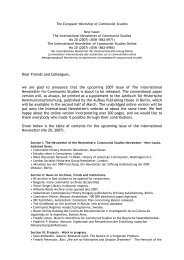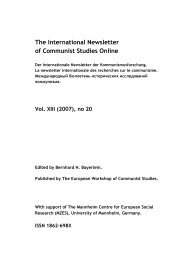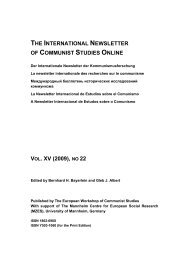The International Newsletter of Communist Studies Online IX
The International Newsletter of Communist Studies Online IX
The International Newsletter of Communist Studies Online IX
You also want an ePaper? Increase the reach of your titles
YUMPU automatically turns print PDFs into web optimized ePapers that Google loves.
<strong>The</strong> <strong>International</strong> <strong>Newsletter</strong> <strong>of</strong> <strong>Communist</strong> <strong>Studies</strong> <strong>Online</strong> 16/2003 59<br />
imprisonment for his political activities and on additional charges that his brother, Ervend, was an NKVD<br />
operative. Hewas the Comintern <strong>of</strong>ficial in charge <strong>of</strong> Iran to whom Shoureshian (»Mazloum«) reported on the<br />
occasions <strong>of</strong> his clandestine trips to Iran. His name was mentioned in the investigation and trial <strong>of</strong> the »Fifty-<br />
three« Group. His fate after 1936 is not known, but it is not difficult to assume that he was liquidated during the<br />
Stalinist purges.<br />
Aslani, Nasrollah<br />
Nasrollah Aslani, (known as Kamran, alias Abdolsamad Motash [alias at the 7 th Comintern congress?]), born in<br />
1904 in Qazvin 59 , was the son <strong>of</strong> a peasant. He grew up in Qazvin, received a high-school education, and began<br />
working in the post <strong>of</strong>fice <strong>of</strong> the city. He was recruited by A. Kambakhsh into the Anjaman-e Parvaresh <strong>of</strong><br />
Qazvin, a cultural society organized by leftists and communists. 60 As a result <strong>of</strong> his activities in that society, he<br />
was, in 1926, appointed by his post <strong>of</strong>fice superiors to a far-<strong>of</strong>f post out <strong>of</strong> town. During his service in the post<br />
<strong>of</strong>fice in 1925–1926 he came into contact with the Russian consul Kaufamann, first through a consular<br />
employee and later meeting him directly. Kamran made the claim that he helped revolutionaries during the<br />
events in Gilan by passing their mail through the British censure in Qazvin – a claim that is very difficult, if not<br />
impossible, to verify (at the time he was no more than sixteen years <strong>of</strong> age). In his personal questionnaire filled<br />
out for the Seventh Comintern Congress, he claims to have joined the All-Russian <strong>Communist</strong> Party in 1928,<br />
but the ICP in 1922, which is in contradiction with his statement that he was recruited by Kambakhsh who<br />
joined the party in 1924.<br />
In 1926 Kamran went to the USSR and studied until 1930 at KUTV as an ICP student, where he was »always first«<br />
in his class and a member <strong>of</strong> the Partcommissia <strong>of</strong> the leadership <strong>of</strong> foreign students at KUTV. In 1930 he was<br />
sent by the Comintern to Iran to carry out party activity. Until 1931, as member <strong>of</strong> city bureau <strong>of</strong> the ICP, he did<br />
party work in Isfahan, where he was engaged as an iron-smith (or lock-smith) at the Kazerouni textile factory.<br />
Here he claims to have organized the workers into a union and led the 1931 strike in that factory. 61 He must<br />
have done this in collaboration with party leader Abdol-Hussein Hesabi (Dehzad) who was at this time in<br />
Isfahan on party assignment (see his biography). Arrested, along with other labor leaders, he was banished to<br />
Abadeh, from whence he was recalled to Tehran for further interrogation. He claimed to have managed to<br />
elude his police escort and to have escaped on the way to Tehran. He lived in the capital for a year in secret<br />
and then returned to the USSR in May 1932. <strong>The</strong>re he re-entered the KUTV as an »aspirant« (teaching<br />
candidate) and also studied for a year in the »special course« until 1934. 62 He claimed that he was, in the<br />
59 Based on his autobiography written for the archives <strong>of</strong> the Comintern cadres, RGASPI, 495/217/199, pp. 59-<br />
61; ibid. 494/1/495, pp. 219ff.; Kambaksh Secret Report to the NKVD and the Comintern, RGASPI, 495/74/194.<br />
60 In his biographical note on Kambakhsh written for the archives <strong>of</strong> the Comintern cadres, Kamran states that<br />
he had been recruited in Qazvin into the ICP by Kambakhsh in the first place. Kamran (Aslani), »A.<br />
Kambakhsh,« RGASPI, 495/217/4, p. 133.<br />
61 For the ICP accounts <strong>of</strong> the strike, see Paykar (no. 9, 1931, and Nahzat (no. 1, 1932), repr. in Chaqueri,<br />
Historical Documents XXII and VI, respectively.<br />
62 <strong>The</strong> NKVD Report to Dimitrov puts his year <strong>of</strong> finishing the KUTV as 1933.














